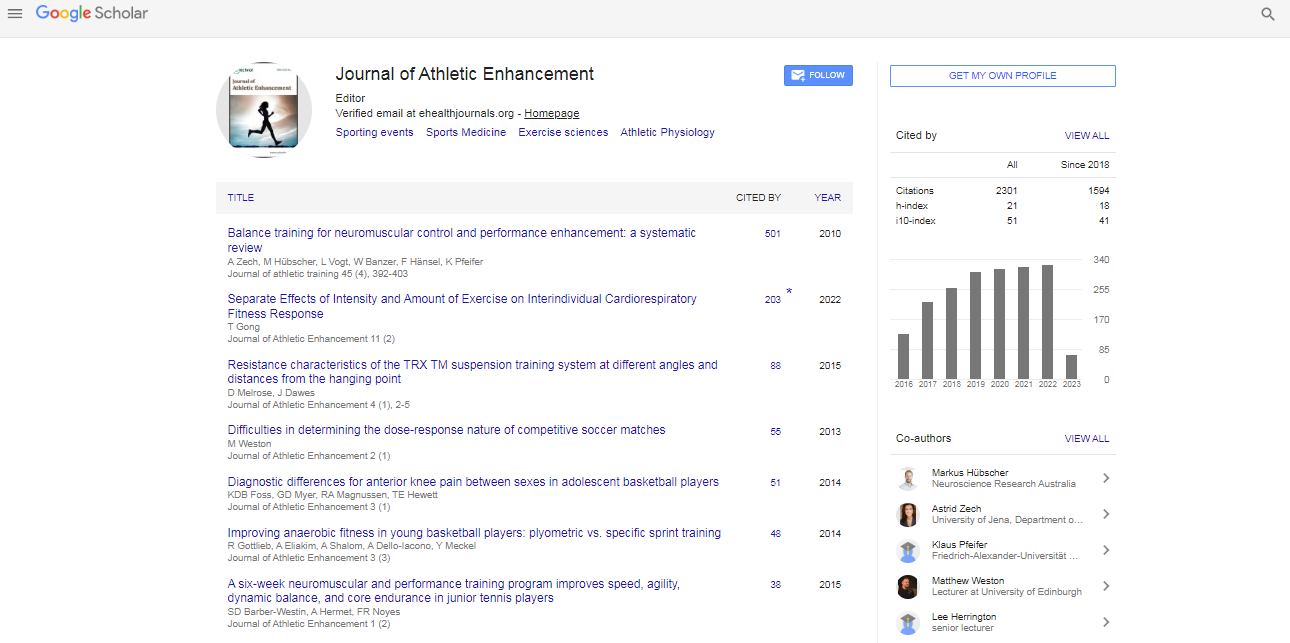Commentary, J Athl Enhanc Vol: 13 Issue: 3
An Overview on Preventing Muscle Injury in Physical Activity
Nicholas Hughes*
1Department of Sports, University of Pittsburgh Medical Center, Pittsburgh, United States of America
*Corresponding Author: Nicholas Hughes,
Department of Sports, University of
Pittsburgh Medical Center, Pittsburgh, United States of America
E-mail: hughesnicholas@ac.edu
Received date: 26 April, 2024, Manuscript No. JAE-24-137836;
Editor assigned date: 29 April, 2024, PreQC No. JAE-24-137836 (PQ);
Reviewed date: 14 May, 2024, QC No. JAE-24-137836;
Revised date: 20 May, 2024, Manuscript No. JAE-24-137836 (R);
Published date: 27 May, 2024, DOI: 10.4172/2324-9080.1000125
Citation: Hughes N (2024) An Overview on Preventing Muscle Injury in Physical Activity. J Athl Enhanc 13:3.
Description
Engaging in physical activity is essential for maintaining a healthy lifestyle, but it also comes with the risk of muscle injury. Whether you're an athlete, a fitness enthusiast, or simply someone who enjoys recreational sports, understanding the causes, symptoms, and prevention of muscle injuries is important for optimizing performance and avoiding setbacks.
Causes of muscle injuries
Several factors contribute to the development of muscle injuries, including:
Overexertion: Pushing yourself beyond your physical limits or increasing the intensity of your workouts too quickly can strain your muscles and increase the risk of injury.
Poor conditioning: Inadequate strength, flexibility, or endurance can make your muscles more susceptible to injury, especially during high-impact activities or sports.
Improper technique: Performing exercises with incorrect form or biomechanics can place excessive stress on certain muscles, leading to strain or tear.
Fatigue: Fatigue diminishes your muscles' ability to absorb shock and maintain proper form, making you more vulnerable to injury, particularly in the later stages of physical activity.
Lack of warm-up: Failing to adequately warm up before engaging in vigorous exercise can reduce blood flow to the muscles, impair flexibility, and increase the likelihood of injury.
Symptoms of muscle injuries
Recognizing the signs and symptoms of muscle injuries is essential for prompt diagnosis and treatment. Common indicators include:
Pain or tenderness: Persistent pain, soreness, or tenderness in the affected muscle, especially during movement or palpation, may signify an injury.
Swelling: Inflammation and swelling around the injured area are typical responses to muscle damage, indicating an inflammatory process is underway.
Reduced range of motion: Difficulty moving the injured muscle or joint through its full range of motion suggests impairment or restriction due to injury.
Weakness or instability: Muscle weakness, instability, or inability to bear weight on the affected limb may indicate significant damage or tear.
Bruising: Visible bruising or discoloration over the injured muscle suggests bleeding or hematoma formation within the tissue.
Prevention strategies
While some degree of risk is inherent in physical activity, adopting preventive measures can significantly reduce the likelihood of muscle injuries. Here are some practical strategies to consider:
Gradual progression: Gradually increase the intensity, duration, and frequency of your workouts to allow your muscles adequate time to adapt and strengthen.
Proper technique: Learn and practice proper exercise technique under the guidance of a qualified instructor or coach to minimize the risk of injury.
Warm-up and cool-down: Always begin your workouts with a dynamic warm-up to increase blood flow, flexibility, and joint mobility. Similarly, conclude your sessions with a cool down to facilitate muscle recovery and prevent stiffness.
Cross-training: Incorporate a variety of activities and exercises into your fitness routine to prevent overuse injuries and promote overall muscle balance and conditioning.
Treatment and rehabilitation
In the event of a muscle injury, immediate first aid and proper management are crucial to facilitate healing and prevent complications. The RICE protocols Rest, Ice, Compression, and Elevation can help alleviate pain, reduce swelling, and promote recovery in the acute phase. Additionally, seeking medical evaluation and guidance from a healthcare professional is essential, especially for severe or persistent injuries. Rehabilitation and physical therapy play a vital role in restoring strength, flexibility, and function following a muscle injury.
A structured rehabilitation program tailored to your specific needs can expedite recovery, reduce the risk of recurrence, and optimize long-term outcomes. Muscle injuries are a common occurrence in physical activity, but with proper awareness, preparation, and preventive measures, their incidence can be minimized. By understanding the causes, symptoms, and prevention strategies outlined in this note, you can better protect yourself from muscle injuries and continue to enjoy the benefits of an active lifestyle safely. Remember, listening to your body, respecting its limits, and prioritizing injury prevention are key to staying healthy, fit, and active for years to come.
 Spanish
Spanish  Chinese
Chinese  Russian
Russian  German
German  French
French  Japanese
Japanese  Portuguese
Portuguese  Hindi
Hindi 
